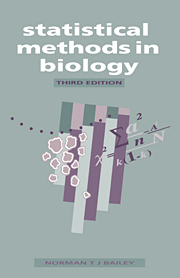Book contents
- Frontmatter
- Contents
- Preface
- 1 Introduction
- 2 Variability and frequency distributions
- 3 Estimation, standard errors and confidence limits
- 4 The basic idea of a significance test
- 5 Simple significance tests based on the normal distribution
- 6 The use of t-tests for small samples
- 7 Contingency tables and χ2
- 8 χ2-tests of goodness-of-fit and homogeneity
- 9 The correlation of measurements
- 10 Regression analysis
- 11 Simple experimental design and the analysis of variance
- 12 Introduction to factorial experiments
- 13 Random samples and random numbers
- 14 Partial correlation and multiple regression
- 15 Non-parametric and distribution-free tests
- 16 Notes on numerical calculation, calculators and computers
- Suggestions for more advanced reading
- Summary of statistical formulae
- Appendix tables
- Index
13 - Random samples and random numbers
Published online by Cambridge University Press: 05 June 2012
- Frontmatter
- Contents
- Preface
- 1 Introduction
- 2 Variability and frequency distributions
- 3 Estimation, standard errors and confidence limits
- 4 The basic idea of a significance test
- 5 Simple significance tests based on the normal distribution
- 6 The use of t-tests for small samples
- 7 Contingency tables and χ2
- 8 χ2-tests of goodness-of-fit and homogeneity
- 9 The correlation of measurements
- 10 Regression analysis
- 11 Simple experimental design and the analysis of variance
- 12 Introduction to factorial experiments
- 13 Random samples and random numbers
- 14 Partial correlation and multiple regression
- 15 Non-parametric and distribution-free tests
- 16 Notes on numerical calculation, calculators and computers
- Suggestions for more advanced reading
- Summary of statistical formulae
- Appendix tables
- Index
Summary
THE NEED FOR RANDOM SELECTION
Frequently in this book we have talked about ‘random’ samples and ‘random’ selection. The word ‘random’ has been used in a more or less intuitive way to imply the purely haphazard and unbiased collection of measurements or allocation of treatments to the experimental material. At the same time, it has been hinted that it is often necessary to ensure that the events in question are sufficiently random by appealing to some special technique. Although one can easily get into deep philosophical waters over questions of the ‘true meaning of randomness’, it is unnecessary to broach such difficulties here. So far as the experimenter is concerned, he or she wants to avoid the sort of bias that will lead him or her to infer, for instance, real differences between treatments, when the observed differences are due merely to some heterogeneity in the test material. We shall therefore discuss randomness only in relation to avoiding various forms of conscious and unconscious bias. The use of tables of random numbers is the chief means of achieving this object. (It is, however, worth mentioning in passing that randomisation in properly designed experiments, such as those with randomised blocks, for example, does in fact make the usual significance tests approximately valid even when the assumption of normally distributed residual variation does not hold.)
The possibility of simple forms of bias will of course occur quite naturally to the competent experimenter.
Information
- Type
- Chapter
- Information
- Statistical Methods in Biology , pp. 146 - 155Publisher: Cambridge University PressPrint publication year: 1995
